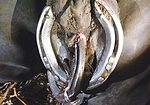Advertise Follow Us
Articles Tagged with ''hoof capsule''
Two Shoes, One Hoof
It’s essential to treat penetrating injuries to the hoof capsule as emergency situations
Read More
Product Showcase
A Sampling of Soaks and Poultices
Hoof treatment manufacturers and distributors list what they find are the benefits of using their products
Read More
Vet's Corner
Farrier, Vet Teamwork Critical with Foot Surgeries
Most of these cases require both the veterinarian and farrier to achieve optimal results
Read More
Heard at the Summit
Heart Bars As Remodeling Tools
Pennsylvania farrier uses the shoe to keep competitive hunters and jumpers at work and in competition
Read More
The Widest Part of the Foot
A study of locating internal hoof structures from external references
Read More
Conformation's Influence on Motion
Understanding the subtle details of a horse’s conformation will best prepare you for effective trimming and shoeing
Read More
Dealing with Sheared Heels
The causes of this common problem may be more complex than they appear on the surface
Read More










